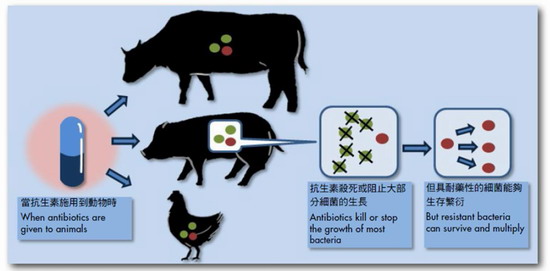
Food Safety Focus (114th Issue, January 2016) – Incident in Focus
Antibiotics and Food Safety
Dr. Ivan CHONG, Veterinarian,
Risk Assessment Section,
Centre for Food Safety
Late last year, the World Health Organization (WHO) held its first World Antibiotic Awareness Week in an attempt to increase awareness of global antibiotic resistance. This article aims to explore the use of antibiotics in food producing animals and their implications to food safety including their potential residues in food and the development of antibiotic resistant bacteria.
Use of Antibiotics in Food Producing Animals
First introduced in the 1940s, antibiotics are medicines that kill or stop the growth of bacteria. Since their introduction, they are widely used in human as well as veterinary medicine. According to the WHO, approximately half of current antibiotic production is used in agriculture including food animal production. Antibiotics are used therapeutically to treat animals with infectious diseases, prophylactically to prevent diseases or their spread within a herd and, in some places, for growth promotion where they are typically given in low doses in the feed and/or water as they increase the rate of weight gain and/or the efficiency of feed utilisation in animals.
Antibiotic Residues in Food
Just like many other veterinary drugs, the use of antibiotics in food animals has the potential to leave residues in animal products such as meat and milk. While low level residues of certain antibiotics are considered safe in some food products, residues of other antibiotics (e.g. chloramphenicol) may pose unacceptable risk to public health and are therefore prohibited to be used in food animals.
In Hong Kong, the Harmful Substances in Food Regulations (Cap. 132AF) (the Regulations) implemented in 1983 govern the import and sale of food containing harmful substances. In 2001, significant enhancements were made to the Regulations to include antibiotics as well as other veterinary drugs in the two Schedules to the Regulations. Currently, the maximum concentrations of 38 veterinary drugs (the majority of which are antibiotics) in different foods are specified in the First Schedule of the Regulations, in which the name of the veterinary drug, description of the veterinary drug, description of the food and the maximum concentration of that veterinary drug allowed are listed. Moreover, a total of seven veterinary drugs (including two antibiotics) that are prohibited in any fish, meat or milk are listed in the Second Schedule to the Regulations.

Development of resistant bacteria in animals when antibiotics are used (Adapted from US CDC)
Emergence and Spread of Antibiotic Resistant Bacteria
When antibiotics are administered to animals, they kill or stop the growth of susceptible bacteria in the intestine. At the same time, some resistant bacteria in the intestine survive or remain unaffected and multiply, leading to the development of an antibiotic resistant bacterial population. Misuse, overuse or the use of antibiotics for growth promotion can potentially accelerate this process as long-term, low-level exposure to antibiotics may lead to survival and growth of resistant bacteria. Humans can become exposed to and subsequently infected by these resistant bacteria through the handling or consumption of contaminated food or through direct contact with animals harbouring these bacteria.
Should We Stop the Use of Antibiotics in Food Producing Animals?
As pointed out by the World Organisation for Animal Health (OIE), antibiotics are essential tools for protecting animal health and animal welfare. When used appropriately, antibiotics also contribute to satisfying the increasing world demand of safe food of animal origin such as milk, meat, fish and eggs. Without antibiotics, food animals suffering from bacterial infectious diseases will be denied effective treatment and outbreaks of disease may not be effectively controlled or prevented within a herd. With more than 60% of human pathogens today originating from animals, leaving sick food animals untreated poses a risk to both food safety and public health.
The OIE, WHO, as well as Food and Agriculture Organization of the United Nations (FAO) all recommend prudent and responsible use of antimicrobials including antibiotics. In general, antibiotics should only be used when indicated and when used in food animals, they should be under veterinary supervision. Efforts should also be made to reduce the use of antibiotics by implementing good animal husbandry practices. According to the Code of Practice to Minimize and Contain Antimicrobial Resistance prepared by Codex, antibiotics should not be used for growth promotion without appropriate risk analysis. The WHO also advises against the use of antibiotics for growth promotion.
According to FAO, prudent use of veterinary drugs including antibiotics has tremendous benefits to animal health and the judicious use of antibiotics in agriculture should reduce the emergence and spread of resistant bacteria in animals, and minimise public health risks.
Key Points to Note
- Antibiotics are essential tools for protecting animal health and animal welfare.
- While low level residues of certain antibiotics are considered safe in some food products, residues of other antibiotics may pose unacceptable risk to public health.
- Misuse and overuse of antibiotics may accelerate the development of antibiotic resistance.
Advice to the Consumers
- Purchase food of animal origin from reliable source.
- Observe good hygiene when preparing food, particularly those from animal origin (e.g. raw meat), including washing hands with soap after contact with raw meat.
- Cook food thoroughly before consumption.
Advice to the trade
- Ensure that antibiotics given to animals are only used under veterinary supervision.
- Obtain food of animal origin from sources that follow Good Practice in the Use of Veterinary Drugs.
- Fresh (i.e. not chilled or frozen) pork, beef and goat meat should only be obtained from animals slaughtered in one of the licensed locals slaughterhouses.
- Importation of chilled/frozen meat or chilled/frozen poultry meat must be accompanied by an import licence from the Centre for Food Safety.

